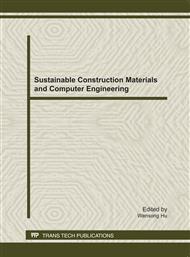[1]
T. Shioiri, T. Kamikawaji, E. Kaneko, M. Homma, H. Takahashi, and I. Ohshima, Influence of electrode area on conditioning in vacuum gap breakdown, IEEE Trans. Dielectr. Elect. Insul., vol. 2, no. 2, p.317–320, Apr. (1995).
DOI: 10.1109/94.388258
Google Scholar
[2]
T. Shioiri, I. Ohshima, M. Honda, H. Okumura, H. Takahashi, and H. Yoshida, Impulse voltage field emission characteristics and breakdown dependency upon field strength in vacuum gaps, IEEE Trans. Power App. Syst., vol. 101, no. 10, p.4178–4184, Oct. (1982).
DOI: 10.1109/tpas.1982.317097
Google Scholar
[3]
T. Fugel and D. Koenig, Influence of grading capacitors on the breaking performance of a 24-kV vacuum breaker series design, IEEE Trans. Dielectr. Elect. Insul., vol. 10, no. 4, p.569–575, Aug. (2003).
DOI: 10.1109/tdei.2003.1219639
Google Scholar
[4]
T. Shioiri, Y. Niwa, T. Kamikawaji, and M. Homma, Investigation of breakdown breakdown probability distribution for double-break vacuum circuit breaker, in Proc. 20th Int. Symp. Discharges Elect. Insul. Vacuum, p.323–326, (2002).
DOI: 10.1109/isdeiv.2002.1027374
Google Scholar
[5]
N. Ide, O. Tanaka, S. Yanabu, S. Kaneko, S. Okabe, and Y. Matsui, Interruption characteristics of double-break vacuum circuit breakers, IEEE Trans. Dielectr. Electr. Insul., vol. 15, no. 4, p.1065–1072, Aug. (2008).
DOI: 10.1109/tdei.2008.4591229
Google Scholar
[6]
E. Dullni and E. Schade, Investigation of high-current interruption of vacuum circuit breakers, IEEE Trans. Elect. Insul., vol. 28, no. 4, p.607–620, Aug. (1993).
DOI: 10.1109/14.231543
Google Scholar
[7]
X. H. Yang, S. H. Liang, X. H. Wang, P. Xiao and Z. K. Fan, Effect of WC and CeO2 on microstructure and properties of W–Cu electrical contact material, Int. J. Refract. Met. Hard Mater., vol. 28, p.305–311, (2010).
DOI: 10.1016/j.ijrmhm.2009.11.009
Google Scholar
[8]
Y. P. Wang, L. N. Zhang, B. J. Ding, and J. E. Zhou , Effect of selective strengthening of CuCr contact materials on the breakdown strength in a short vacuum gap, Proceedings of the CSEE, vol. 19, no. 3, pp.46-49, Mar. (1999).
Google Scholar
[9]
C. Y. Zhang, Y. P. Wang, Z. M. Yang, Y. Guo and B. J. Ding, Microstructure and properties of vacuum induction melted CuCr25 alloys, J. Alloys Compd., vol. 366, p.289–292, (2004).
DOI: 10.1016/j.jallcom.2003.07.001
Google Scholar
[10]
Y. P. Wang and B. J. Ding, The Preparation and the Properties of Microcrystalline and Nanocrystalline CuCr Contact Materials, IEEE Trans. on components and packaging technology, vol. 22, no. 2, pp.467-472, Jun. (1999).
DOI: 10.1109/6144.796552
Google Scholar
[11]
F. Zhao , H. Xu, Z. M. Yang and B. J. Ding, Preparation of CuCr25 alloys through vacuum arcs melting and their properties, .Trans.Nonferrous Met. .Soc. .China, vol. 10, no. 1, pp.73-75, (2000).
Google Scholar
[12]
X. H. Yang, S. M. Li, Z. K. Fan, S. H. Liang and P. Xiao, Properties of CuFeW Electrical Contact Materials, High Voltage Apparatus, vol. 44, no. 6, pp.537-540, Dec. (2008).
Google Scholar
[13]
Q. Huang, Solid Physics, Beijing, High Education Press, 1988, pp.288-290 (in Chinese).
Google Scholar
[14]
H. Gleiter, J. Weissmqller, O. Wollersheim, and R. Wqrschum, Nanocrystalline Materials: A Way To Solids With Tunable Electronic Structures And Properties?, Acta Mater., vol. 49, pp.737-745, (2001).
DOI: 10.1016/s1359-6454(00)00221-4
Google Scholar
[15]
J. Wang, C. Y. Zhang, H. Zhang, Z. M. Yang and B. J. Ding, CuCr25W1Ni2 contact material of vacuum interrupter, Trans Nonferrous Met Soc China, vol. 11, no2, pp.226-230, (2001).
Google Scholar
[16]
F. Z. Wang, F. Zhuge, H. Zhang and B. J. Ding, Effect of high content no-thoria addition on the properties of tungsten electrode, Mater. Res. Bull., vol. 38, pp.629-636, (2003).
DOI: 10.1016/s0025-5408(03)00005-9
Google Scholar


